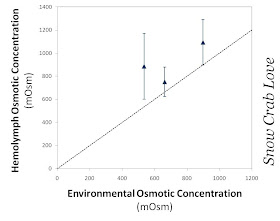"I told you not to eat your sister!"
Well, you’re not alone. A new paper has come out in the Journal of Crustacean Biology (I may have squeeled when I saw this year’s purple cover) about Chionoecetes opilio larval release. Penny Kuhn, Sara Graham, and Jae Choi looked at whether or not hatch timing of embryos is dependent on their mothers’ presence. You see, some crab moms, like Sesarma cinereum and Uca pugilator, can control larval release. They may send signals to their embryos to start releasing enzymes important in the hatching process. Conversely, embryos of Dyspanopeus sayi and Rhithropanopeus harrisii may release their own pheromones to instigate hatching.
Kuhn et al. wanted to know which control was the case for snow crab larval release: mom versus embryo. They did this by detaching embryos from female snow crab clutches and placing them in completely dark tanks with ambient water (to mimic being hidden within the mothers’ abdominal flaps). Larval release was monitored for both attached and detached embryos and found to be “relatively synchronous”, meaning that the mothers don’t initiate hatching. In fact, detached embryos were able to successfully hatch up to 2 weeks after they were removed from the clutch!
hatching of attached and detached eggs from one of the study female opies:
see how the peaks are pretty consistant/synchronized?!?
Previously, hatching synchrony had been seen up to 10 days post-removal in Homarus gammarus and only up to 5 days post-removal in Rhithropanopeus harrisii, so the matched hatch-timing 14 days after separation from mom is pretty impressive. Clearly, snow crab babies were not relying on any message or signal the moms might have given.
So snow crab moms may have no say when their larvae are released into the ocean; they just get no respect!
Mom v Embryo:
Kuhn, P. S., S. Graham, and J. S. Choi. 2011. Influence of senescent algae, temperature, tides, currents, and embryo detachment on Chionoecetes opilio (snow crab) larval release. Journal of Crustacean Biology 31: 100-105.
(The bulk of the paper also looked at different potential triggers of larval release: senescent algae, tides, currents. I don’t want to give any more away though, so you’ll have to read it yourself! Also, you can find the references for the other cited research in the Kuhn et al. paper.)
(The bulk of the paper also looked at different potential triggers of larval release: senescent algae, tides, currents. I don’t want to give any more away though, so you’ll have to read it yourself! Also, you can find the references for the other cited research in the Kuhn et al. paper.)

































